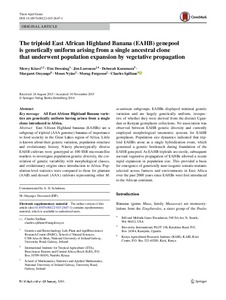| dc.contributor.author | Kitavi, M. |
| dc.contributor.author | Downing, T. |
| dc.contributor.author | Lorenzen, J.H. |
| dc.contributor.author | Karamura, D. |
| dc.contributor.author | Onyango, M. |
| dc.contributor.author | Nyine, M. |
| dc.contributor.author | Ferguson, M. |
| dc.contributor.author | Spillane, Charles |
| dc.date.accessioned | 2019-12-04T10:57:26Z |
| dc.date.available | 2019-12-04T10:57:26Z |
| dc.date.issued | 2016-01-08 |
| dc.identifier.citation | Kitavi, M., Downing, T., Lorenzen, J., Karamura, D., Onyango, M., Nyine, M., Ferguson, M. & Spillane, C. (2016). The triploid East African Highland Banana (EAHB) genepool is genetically uniform arising from a single ancestral clone that underwent population expansion by vegetative propagation. Theoretical and Applied Genetics, 1-15. |
| dc.identifier.issn | 0040-5752 |
| dc.identifier.uri | https://hdl.handle.net/20.500.12478/738 |
| dc.description.abstract | East African Highland bananas (EAHBs) are a subgroup of triploid (AAA genome) bananas of importance to food security in the Great Lakes region of Africa. Little is known about their genetic variation, population structure and evolutionary history. Ninety phenotypically diverse EAHB cultivars were genotyped at 100 SSR microsatellite markers to investigate population genetic diversity, the correlation of genetic variability with morphological classes, and evolutionary origins since introduction to Africa. Population-level statistics were compared to those for plantain (AAB) and dessert (AAA) cultivars representing other M. acuminata subgroups. EAHBs displayed minimal genetic variation and are largely genetically uniform, irrespective of whether they were derived from the distinct Ugandan or Kenyan germplasm collections. No association was observed between EAHB genetic diversity and currently employed morphological taxonomic systems for EAHB germplasm. Population size dynamics indicated that triploid EAHBs arose as a single hybridization event, which generated a genetic bottleneck during foundation of the EAHB genepool. As EAHB triploids are sterile, subsequent asexual vegetative propagation of EAHBs allowed a recent rapid expansion in population size. This provided a basis for emergence of genetically near-isogenic somatic mutants selected across farmers and environments in East Africa over the past 2000 years since EAHBs were first introduced to the African continent. |
| dc.format.extent | 1-15 |
| dc.language.iso | en |
| dc.subject | Bananas |
| dc.subject | Food Security |
| dc.title | The triploid East African Highland Banana (EAHB) genepool is genetically uniform arising from a single ancestral clone that underwent population expansion by vegetative propagation |
| dc.type | Journal Article |
| dc.description.version | Peer Review |
| cg.contributor.crp | Roots, Tubers and Bananas |
| cg.contributor.affiliation | National University of Ireland |
| cg.contributor.affiliation | International Institute of Tropical Agriculture |
| cg.contributor.affiliation | Bill & Melinda Gates Foundation |
| cg.contributor.affiliation | Bioversity International |
| cg.contributor.affiliation | Kenya Agricultural Research Institute |
| cg.coverage.region | Africa |
| cg.coverage.region | East Africa |
| cg.coverage.country | Kenya |
| cg.isijournal | ISI Journal |
| cg.authorship.types | CGIAR and developing country institute |
| cg.iitasubject | Banana |
| cg.journal | Theoretical and Applied Genetics |
| cg.howpublished | Formally Published |
| cg.accessibilitystatus | Limited Access |
| local.dspaceid | 71851 |
| cg.targetaudience | Scientists |
| cg.identifier.doi | https://dx.doi.org/10.1007/s00122-015-2647-1 |

